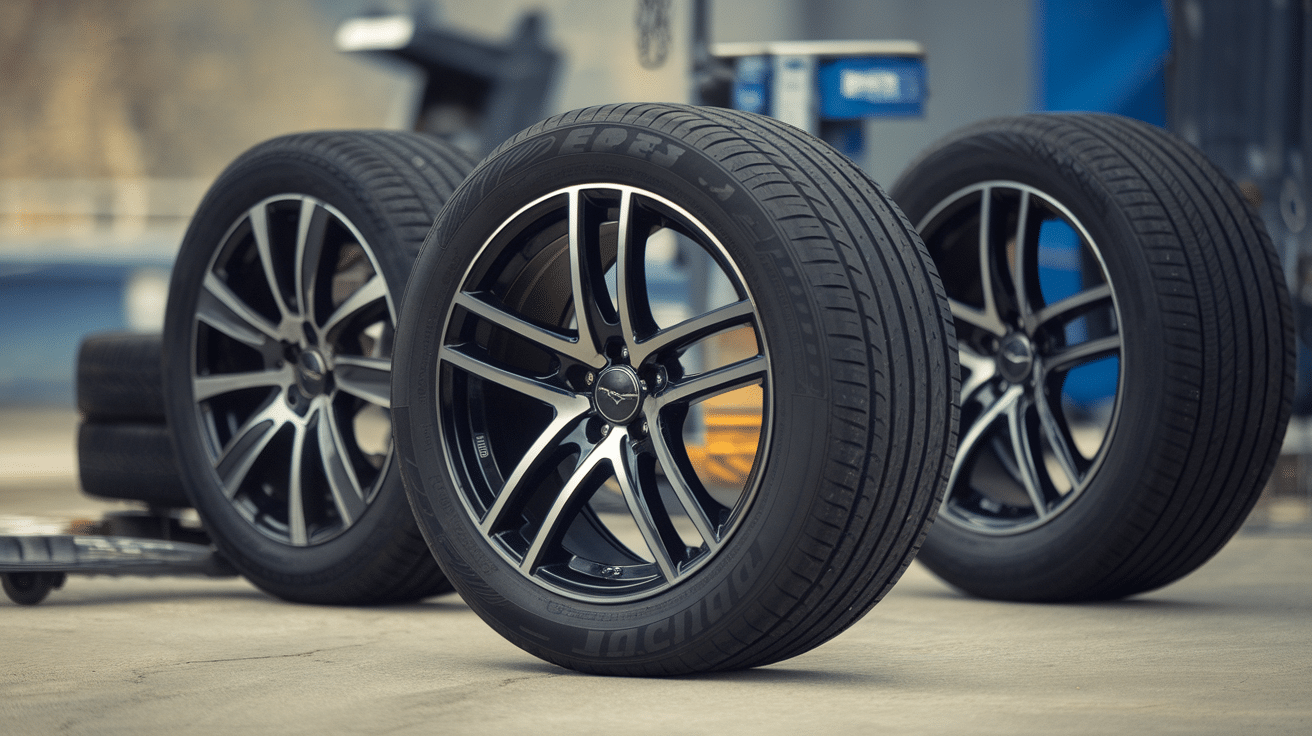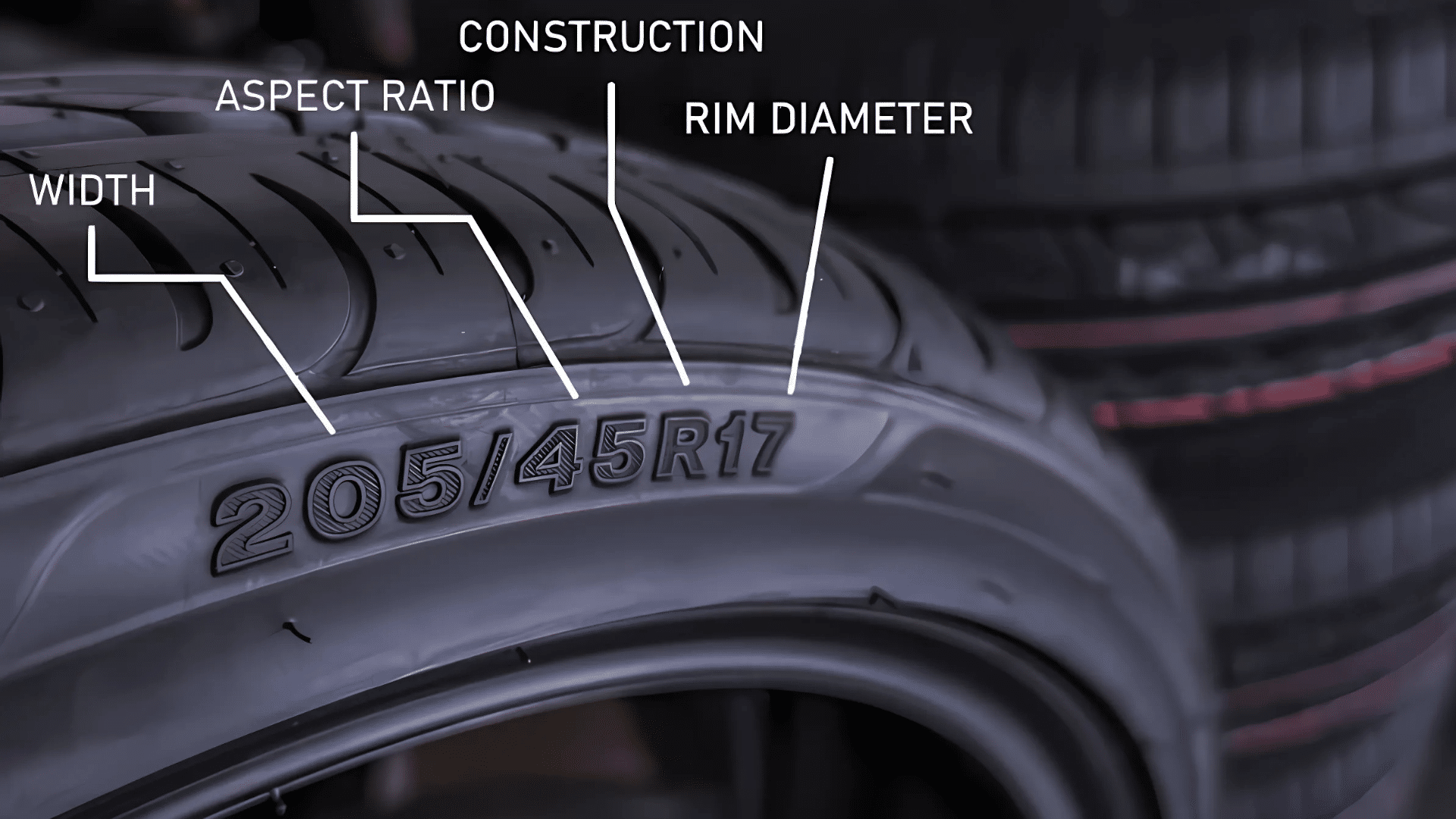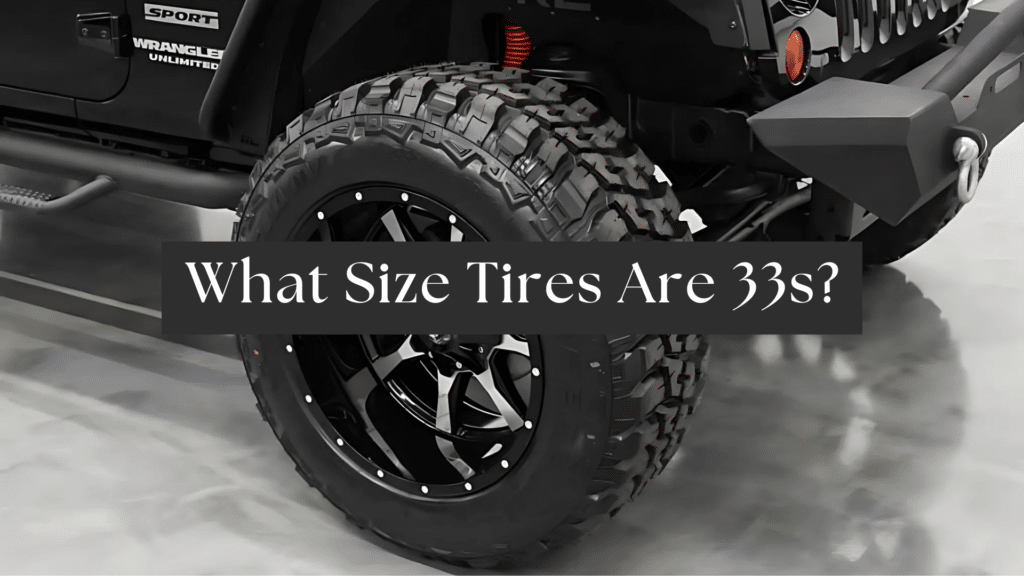When it comes to upgrading your vehicle for off-road use or simply improving its look, one of the most common upgrades is to switch to larger tires. A popular size among off-road enthusiasts is the “33-inch” tire. But what exactly does that mean, and how does it affect your vehicle?
In this blog, I will explain 33-inch tires, how to understand tire sizes, and the benefits and considerations before making the switch; understanding 33-inch tires is the first step in improving your vehicle’s off-road capabilities or enhancing its appearance.
What Does “33-Inch” Mean?

The term “33-inch” refers to the overall diameter of the tire, which means the height of the tire from the ground to the top of the tread when it’s fully inflated.
In simple terms, a 33-inch tire measures about 33 inches tall from the bottom to the top. This measurement is important because it directly affects your vehicle’s clearance.
Larger tires, like the 33-inch ones, increase the distance between your vehicle’s frame and the ground, giving you better ground clearance. This can be helpful when driving over obstacles such as rocks, curbs, or rough terrain and is one of the main reasons people opt for 33-inch tires, especially on off-road vehicles.
Common 33-Inch Tire Sizes
When people refer to “33-inch tires,” they generally talk about tires with an overall diameter of 33 inches. However, the width, aspect ratio, and rim size can vary. The 10 common tire sizes that are considered to be 33 inches are:
1. 33×10.50R15
- Diameter: 33 inches
- Width: 10.5 inches
- Rim Size: 15 inches
- This tire is narrower than most 33-inch options, making it ideal for off-road vehicles that need traction but want to reduce rolling resistance for better fuel efficiency.
2. 305/70R16
- Diameter: 33 inches
- Width: 305 millimeters
- Rim Size: 16 inches
- With a wider width, this tire offers excellent off-road capability, providing better sand, mud, and gravel traction.
3. 33×9.50R15
- Diameter: 33 inches
- Width: 9.5 inches
- Rim Size: 15 inches
- This tire is a great choice for those who want a narrower footprint, offering better performance in deep snow or mud.
4. 275/65R18
- Diameter: 33 inches
- Width: 275 millimeters
- Rim Size: 18 inches
- Slightly narrower with a lower sidewall, this tire balances off-road and on-road use, making it a good choice for trucks and SUVs.
5. 295/70R17
- Diameter: 33 inches
- Width: 295 millimeters
- Rim Size: 17 inches
- This tire has a wider profile and offers improved traction on tough terrain. It’s perfect for trucks that need extra off-road grip.
6. 275/70R17
- Diameter: 33 inches
- Width: 275 millimeters
- Rim Size: 17 inches
- This is a solid choice for those who need a balanced tire that performs well on highways and off-road trails.
7. 33×12.50R15
- Diameter: 33 inches
- Width: 12.5 inches
- Rim Size: 15 inches
- A wider tire that gives more surface contact for better traction in rough conditions. It is popular for off-road vehicles needing maximum grip.
8. 285/75R16
- Diameter: 33 inches
- Width: 285 millimeters
- Rim Size: 16 inches
- This tire offers a good balance of width and sidewall height, and it is commonly used by trucks with moderate off-road needs.
9. 33×12.50R17
- Diameter: 33 inches
- Width: 12.5 inches
- Rim Size: 17 inches
- Offering a wide, aggressive tread, this tire is ideal for off-roading in challenging conditions like mud, snow, and rocks.
10. 285/70R17
- Diameter: 33 inches
- Width: 285 millimeters
- Rim Size: 17 inches
- Another great option for off-road enthusiasts, this size offers a balance between width and off-road capability.
There are many 33-inch tire options, with different widths and rim sizes depending on your vehicle and driving needs. Understanding the various 33-inch tire sizes can help you make the best decision for your vehicle, whether you’re looking for more off-road traction or improved highway performance.
Understanding Tire Size Notation

Tire sizes may look confusing at first glance, but let’s take a look at how tire sizes are written and what each part of the notation means.
A typical tire size looks something like this: 285/75R16. Here’s what each number and letter represents:
- 285: This is the width of the tire in millimeters. In this case, the tire is 285 millimeters wide.
- 75: This is the aspect ratio, which tells you the height of the tire’s sidewall as a percentage of its width. A 75 aspect ratio means the sidewall height is 75% of the tire’s width.
- R: The “R” stands for “Radial,” meaning the tire’s internal structure has layers arranged radially from the center.
- 16: This number represents the diameter of the rim the tire is designed to fit in inches. In this case, the tire is designed for a 16-inch rim.
Converting to Inches
To calculate the overall diameter of a tire, you need to take the sidewall height and add it to the diameter of the wheel. Here’s how you can calculate the diameter for a tire like the 285/75R16:
- 285mm is the width of the tire.
- The sidewall height is 75% of 285mm or 213.75mm.
- The total diameter is the sidewall height x 2 (for both sides) + rim diameter. In this case:
(213.75mm x 2) + 16 inches (converted to millimeters: 16 x 25.4 = 406.4mm)
= 427.5mm + 406.4mm = 833.9mm, or approximately 33 inches.
This method helps to show that a 285/75R16 is indeed a 33-inch tire, and similar calculations can be done for other tire sizes.
Benefits of 33-Inch Tires
Upgrading to 33-inch tires offers several advantages, especially for off-road enthusiasts and truck owners. Some of the key benefits of using 33-inch tires are:
1. Enhanced Ground Clearance: The larger tire diameter raises the vehicle’s height, making it easier to clear obstacles like rocks, curbs, or uneven terrain. This is particularly beneficial for off-road vehicles.
2. Improved Off-Road Capability: 33-inch tires offer better traction and stability on rough terrains like mud, sand, snow, and gravel. The increased tire size means more surface area is in contact with the ground, which improves grip.
3. Aesthetic Appeal: Larger tires give your vehicle a more aggressive, rugged look. The 33-inch tires add a bold, muscular stance, making your vehicle appear more powerful and capable.
4. Better Traction and Stability: Because 33-inch tires are wider and have a larger surface area, they provide improved traction, especially in slippery or uneven conditions. The added width also helps with stability.
5. Increased Towing and Hauling Capacity: They provide a stronger grip, allowing for better control when carrying heavy loads or towing a trailer. The increased traction helps keep the vehicle stable while towing.
6. Improved Handling: 33-inch tires can improve your vehicle’s performance on rough or poorly paved roads. The larger tires can absorb shocks better and provide a smoother ride, especially when driving over potholes and bumps.
Switching to 33-inch tires can significantly enhance your vehicle’s performance, particularly during off-roading. From improving ground clearance and traction to enhancing the vehicle’s aesthetic appeal, 33-inch tires offer several benefits.
They’re perfect for those who need better performance in tough conditions, more towing capacity, or simply want a stronger, more commanding look for their vehicle.
What to Consider Before Switching to 33-Inch Tires
Upgrading to 33-inch tires can significantly improve your vehicle’s performance and appearance. However, several factors should be considered before making the switch to ensure that the larger tires are a good fit.
1. Vehicle Compatibility
- Larger tires may not fit in the wheel wells without modifications. Some vehicles may require a suspension lift or fender trimming to create enough clearance.
- It’s important to ensure that the new tires won’t rub against the fenders, suspension, or other parts of your vehicle when turning or while driving over bumps.
2. Suspension Modifications
- To accommodate 33-inch tires, you may need to modify the suspension, such as installing a lift kit. A lift kit raises your vehicle’s height, providing the necessary clearance for larger tires.
- Depending on your vehicle’s make and model, you may need to lift the suspension by 2 to 4 inches to prevent rubbing. Be sure to consult with a mechanic or off-road specialist.
3. Speedometer and Odometer Calibration
- Switching to larger tires affects your vehicle’s speedometer and odometer. Since 33-inch tires have a larger diameter, they cover more ground with each rotation, which can lead to inaccurate readings.
- Your speedometer might show a lower speed than you’re actually driving, and your odometer may not track distance correctly. It’s important to have these instruments recalibrated to maintain accurate data.
4. Handling and Performance
- Larger tires can change the handling characteristics of your vehicle. While they offer better off-road performance and increased traction, they may affect your vehicle’s handling on highways and city streets.
- Larger tires may make the vehicle feel less responsive in tight turns, and the increased weight may slow acceleration. Be aware of how the switch will impact your vehicle’s overall driving dynamics.
5. Cost of Upgrading
- Upgrading to 33-inch tires is more expensive than sticking with standard tire sizes. Not only do the tires themselves cost more, but there may be additional expenses.
- This can be for suspension modifications, lift kits, speedometer recalibration, and potential changes to other parts of your vehicle. It’s important to budget for all the costs associated with the upgrade.
6. Wheel Fitment
- When upgrading to 33-inch tires, you may need to choose new wheels (rims) that are compatible with the larger tire size. Ensure that the wheels are the correct width and have the proper bolt pattern to fit your vehicle.
- If you’re changing the rim size along with the tire size, be sure to check the new wheel’s specifications to guarantee a proper fit.
Upgrading to 33-inch tires can enhance your vehicle’s off-road capability, improve its appearance, and provide other performance benefits. Before making the switch, carefully think about these factors or consult a professional to ensure that the tires will fit your vehicle’s needs and driving conditions.
Common Vehicles That Use 33-Inch Tires
33-inch tires are popular among off-road enthusiasts and are often found on trucks, SUVs, and 4×4 vehicles. Some common vehicles that use 33-inch tires include:
1. Jeep Wrangler: Known for its off-road capability, the Jeep Wrangler often uses 33-inch tires for better traction and ground clearance.
2. Ford F-150: The F-150, a popular full-size truck, commonly upgrades to 33-inch tires for enhanced off-road performance and a rugged appearance.
3. Chevrolet Silverado: This full-size pickup truck is often outfitted with 33-inch tires for improved off-road ability and clearance.
4. Toyota Tacoma: A mid-size truck that uses 33-inch tires to provide better handling and performance on rough terrains.
5. Ram 1500: Another popular truck, the Ram 1500, can be fitted with 33-inch tires for improved ground clearance and off-road stability.
6. Toyota 4Runner: This SUV is frequently seen with 33-inch tires to handle off-road adventures while maintaining comfort on the highway.
These vehicles benefit from the added ground clearance, better off-road traction, and enhanced visual appeal provided by 33-inch tires.
Conclusion
Switching to 33-inch tires can bring many benefits, especially for off-road enthusiasts. They provide improved ground clearance, better traction, and a more aggressive look for your vehicle. Whether tackling rocky trails, mud, or sand, 33-inch tires give you the extra capability to handle tough terrains with ease.
However, it’s important to consider factors like vehicle compatibility, suspension modifications, fuel economy, and handling before upgrading. Ensure your vehicle can accommodate the larger tires, and be aware of any additional costs for changes and recalibration.
Consulting a professional will ensure you get the right fit and performance if you’re considering the upgrade. With the right tires, you can enjoy both better off-road performance and an enhanced vehicle appearance.
Frequently Asked Questions
Are 33-inch tires suitable for daily driving?
While 33-inch tires offer great off-road performance, they may reduce fuel efficiency and handling. For daily driving, make sure you’re okay with the trade-offs.
Do I need to lift my truck to install 33-inch tires?
Most vehicles will need at least a slight lift to accommodate 33-inch tires, especially if the stock suspension is low. Check if a lift kit is required.
How do 33-inch tires affect fuel economy?
Larger tires add weight and resistance, which can reduce fuel economy. Expect a slight drop in MPG, but the impact varies based on the vehicle and driving style.
Can I switch back to my original tire size after upgrading to 33 inches?
Yes, you can switch back, but you may need to recalibrate your speedometer and ensure the original tires fit properly without rubbing.
What is the cost difference between 33-inch tires and standard sizes?
33-inch tires are generally more expensive due to their size and off-road capabilities. Expect to pay a bit more for these larger tires compared to standard sizes.


